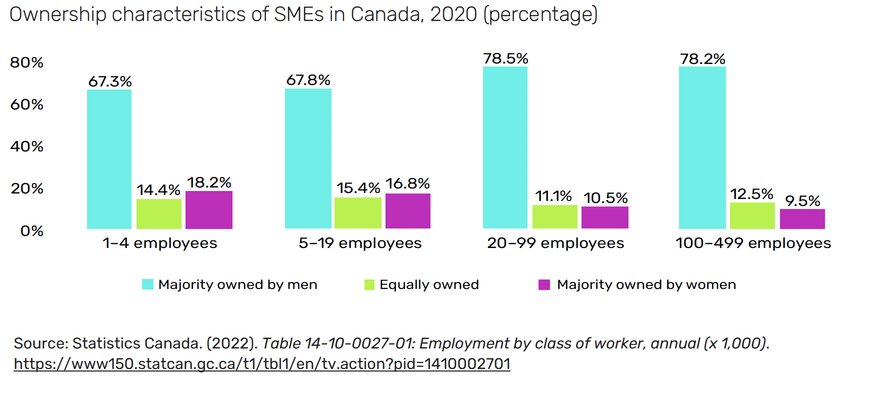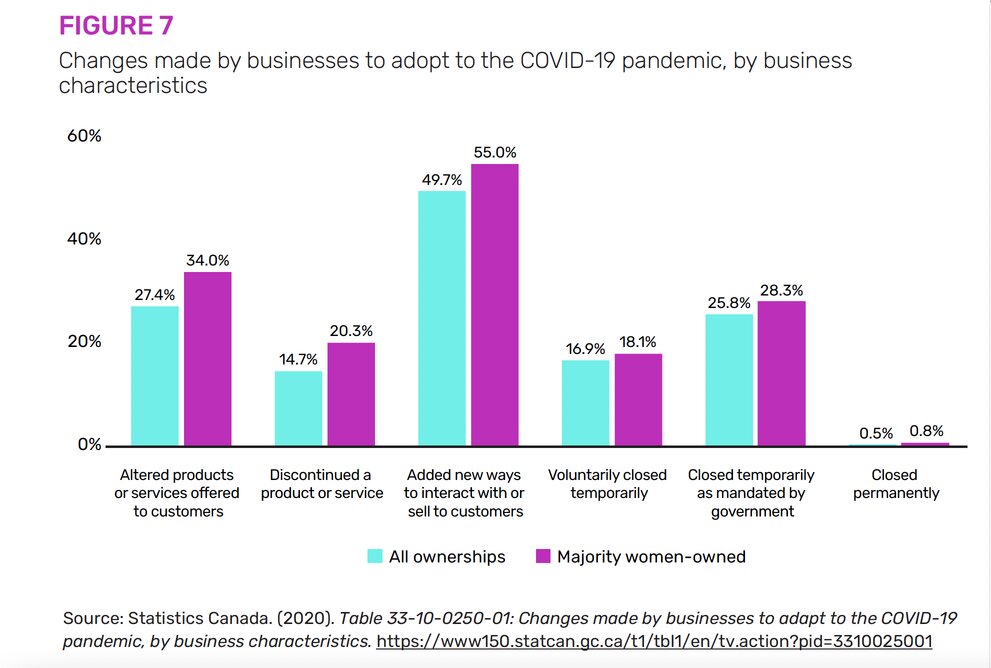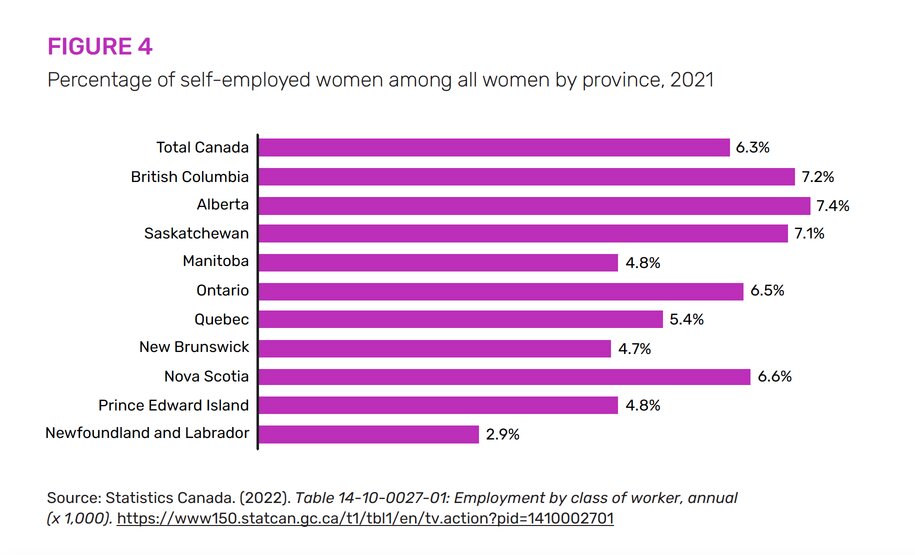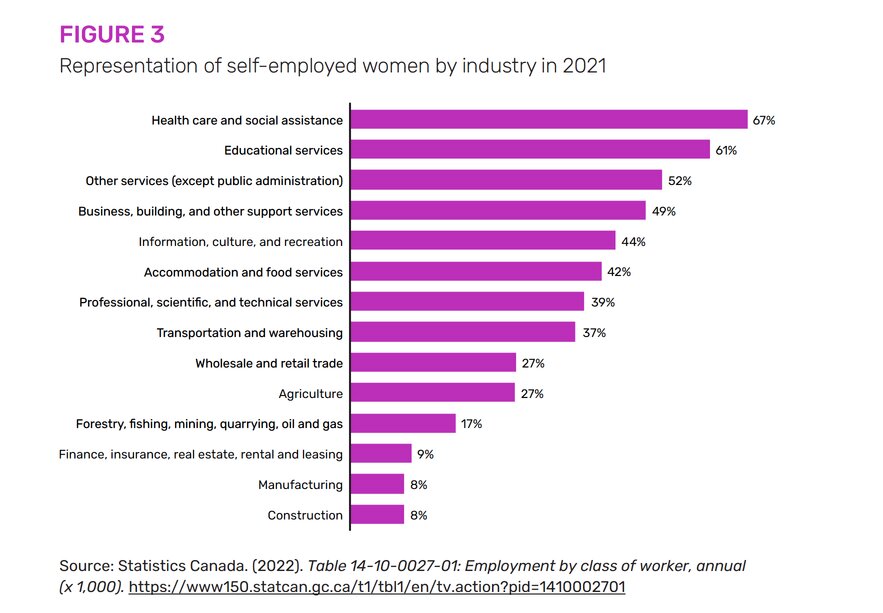The Women Entrepreneurship Knowledge Hub (WEKH) released it’s annual report: The State of Women Entrepreneurship in Canada 2022 on March 28, 2022. The report provided an update on the state of women’s entrepreneurship in Canada based on a synthesis of existing research and the results of new research. The report is the third in a series of reports that review and synthesize research on women’s entrepreneurship in Canada.
The report took an expansive view of women’s entrepreneurship as including both majority owners (more than 50% ownership) of small and medium-sized enterprises (SMEs) and self-employed entrepreneurs.
The Women Entrepreneurship Knowledge Hub (WEKH) is a part of the Government of Canada’s Women Entrepreneurship Strategy that aims to increase women entrepreneurs’ access to financing, talent, networks and expertise. Using a methodology developed by the Boston Consulting Group and the Cherie Blair Foundation.
Here are some great takeaways from The State of Women’s Entrepreneurship in Canada 2022 Report
The report provides an update on the state of women’s entrepreneurship in Canada based on a synthesis of existing research and the results of new research. It begins with an overview of the characteristics of women’s entrepreneurship in Canada, before delving into the impacts of the COVID-19 pandemic on women entrepreneurs, the profiles and experiences of diverse women entrepreneurs, and the enablers and barriers in the women’s entrepreneurship ecosystem at the societal (macro), organizational (meso), and individual (micro) levels.
The report analysis shows that self-employed women, compared to self-employed men, tend to be younger, have higher levels of education, and retire at an earlier age, and they are more likely to hold multiple jobs and be in married or common-law relationships.
It is estimated that closing the gender gap in entrepreneurship in Canada could add $41-$81 billion to Canada’s GDP.
Ownership
In December 2020, women were majority owners of approximately 16.8% of SMEs in Canada, or approximately 205,188 entrepreneurs. Yet, the number of self-employed women in Canada peaked at 1,065,200 in 2019, or 37.2% of all self-employed individuals, before falling to 982,600, or 36.8%, in 2021.

The number of new women-founded start-ups with a valuation of more than US$1 billion (“unicorns”) in Canada has almost doubled since 2019.

Founded in 2015 by Michele Romanow, Andrew D’Souza, Ivan Gritsiniak, Charlie Feng, and Tanay Delima, Clearco (formerly Clearbanc) is a lending platform for start-ups that offers a suite of performance financing products and services.
Trulioo, co-founded in 2011 by Tanis Jorge and Stephen Ufford, is a “RegTech” company dedicated to building and connecting digital identity networks around the globe that provide instant access to hundreds of procured, vetted, and trusted data sources.
Anna Sainsbury co-founded GeoComply in 2010 with David Briggs and Joel Stephano. The company provides fraud protection, secure and accurate geolocation, GPS and GSM geolocation and location compliance services.
1Password was founded in Toronto in 2005 by Dave Teare, Sara Teare, Natalia Karimov, and Roustem Karimov. The company offers businesses and families a safe way to share passwords, credit cards, and documents, keeping important information secure with AES 256-bit encryption.

She-Cession: Impacts of the COVID-19 Pandemic on Women Entrepreneurs
The impacts of the COVID-19 pandemic have disproportionately affected women and women-dominated sectors. As a result, some have defined the current economic state as a “she-cession.” Compared to majority men-owned businesses in the private sector, majority women-owned businesses saw a greater decline in early-stage business activities and more employee layoffs, and women were more likely to sell, shut down, discontinue, or quit their businesses as a result of the pandemic.
Women-owned businesses are more likely to operate in the hardest hit industries—retail, accommodation, education, and services (excluding public service)—and tend to be newer and smaller in size, which makes them more vulnerable to the economic toll of the pandemic.
Diverse Women Entrepreneurs: Profiles and Challenges
Black Women Entrepreneurs
Institutions and organizations designed to support entrepreneurs have entrenched conscious and unconscious biases that exclude Black women and present additional barriers. Black women entrepreneurs also face a lack of encouragement, mentoring, sponsorship, and access to networks and information.
Black business owners tend not to feel confident applying for external funding and taking on debt
According to a survey by the African Canadian Senate Group, only half of empowered (defined as being experienced and supported) Black respondents report feeling comfortable applying for funding from federal and provincial governments. Other survey results show that even fewer Black business owners are comfortable applying for funding from non-profit community organizations (36%), banks (35%), credit unions (33%), and fintech lenders (16%).
Indigenous Women Entrepreneurs
Statistics Canada’s 2020 Survey on Financing and Growth of Small and Medium Enterprises found that 25.5% of SMEs that are majority-owned by Indigenous entrepreneurs are majority-owned by women, in comparison to 64.3% that are majority-owned by men and 10.1% that are equally owned by men and women. The percentage of businesses with annual revenues between $100,000 and $1 million increased from 17% in 2015 to 19% in 2019, and those with over $1 million in annual revenue increased from 4% in 2015 to 9% in 2019.
Indigenous women entrepreneurs face obstacles accessing financing and resources, such as unclear eligibility requirements, unreliable internet connections, lack of networks, and systemic discrimination. The Indian Act also creates distinct challenges for Indigenous business owners in accessing capital and operating their businesses.
Immigrant Women Entrepreneurs
Immigrant, newcomer, and refugee women bring unique perspectives and experiences to Canada that can be leveraged in entrepreneurship to great effect. Many immigrant women entrepreneurs are multilingual and have global experience that sets them apart and enables higher levels of export. In fact, almost double the proportion of businesses led by immigrant women export compared to businesses led by Canadian-born women (16.6% vs. 10.4%).
In terms of innovation, immigrant-owned businesses in Canada are also 8.6% more likely to create new products and 20.1% more likely to implement innovative production processes or methods compared to businesses owned by their Canadian-born counterparts.
Women Entrepreneurs Living with Disabilities
Data does show, however, that persons with disabilities in Canada are less likely (8.6%) to be self-employed than those without disabilities (11.1%).
2SLGBTQ+ Entrepreneurs
Approximately 1 in 40 Canadian businesses are owned or operated by individuals in the 2SLGBTQ+ community, accounting for 28,000 businesses across Canada.
One study found that 28% of businesses owned by 2SLGBTQ+ entrepreneurs experienced discrimination because of the owner’s identity.
Enablers and Barriers in the Ecosystem
Societal (Macro) Level Enablers and Barriers
At the macro level, institutional and societal dynamics have implications for who can become an entrepreneur and in what sector or field. These include government policies and programs, as well as broader stereotypes around entrepreneurship. Some recent developments to support women entrepreneurs include:
- The Canada-Wide Early Learning and Child Care Plan, a $30 billion investment.
- In Budget 2021, the government laid out a plan to provide Canadian parents with, on average, $10-a-day regulated child care spaces for children under six years old, within the next five years, including a 50 per cent reduction in average fees by the end of 2022.
- Reinvestment in the Women Entrepreneurship Strategy, new investments in the Black Entrepreneurship Program, and programs to support Indigenous entrepreneurs.
- The Government of Canada’s 50 – 30 Challenge, which calls on organizations to implement gender parity (50% women and/or non-binary people) and significant representation (30%) of other equity-deserving groups (including racialized people, Indigenous Peoples, people identifying as 2SLGBTQ+, and persons with disabilities) on boards and/or in senior management positions.
Organizational (Meso) Level Enablers and Barriers
At the meso level, the report examine the role postsecondary institutions, financial institutions, investors and venture capitalists, incubators and accelerators, and customers play in supporting entrepreneurship, as well as the barriers that exist within these actors for many women and equity-deserving groups.
Most businesses in Canada start with less than $5,000 in funding, but it remains challenging to get micro-loans and seed funding.
Incubators, accelerators, and other business support organizations play a significant role in helping entrepreneurs survive and thrive. One study, for example, suggested that companies supported by business accelerators and incubators were more likely to have increased employment and growth than others.
Women in Small and Medium-Sized Enterprises

- There were 1,174,693 SMEs in Canada in 20175 and 1,221,357 SMEs as of December 2020.6 The proportion of majority women-owned businesses (over 50% of a business’s ownership) among all SMEs was 16.8% in 2020, compared to 15.6% in 2017.
- In 2020, women were majority owners of 18.2% of all businesses with 1 to 4 employees, men were majority owners of 67.3%, and 14.4% of such businesses were equally owned by men and women.
- As the size of the firm increases, the proportion majority-owned by women decreases.
- In 2020, 10.5% of all businesses with 20 to 99 employees were majority-owned by women, 78.5% were majority-owned by men, and 11.1% were equally owned by men and women
- Among businesses with 100 to 499 employees, women were majority owners of 9.4%, men were majority owners of 78.2%, and 12.5% were equally owned by men and women.

Women in Self Employment
- In recent decades, self-employment among women, particularly young women, grew at a faster rate than among men. The number of self-employed women grew by 315%, from 311,600 in 1976 to 982,600 in 2021, reaching a peak of 1,065,200 self-employed women in 2019.
- However, during the COVID-19 pandemic, the number of self-employed women decreased from 1,065,200 in 2019 to 982,600 in 2021—a reduction of 82,600 people.
Self-employed women are more likely than men to hold multiple jobs. Women account for 59% of self-employed workers who are multiple job holders, compared to 36% who are men.
Economic Impact of Women Entrepreneurship
- In Canada, SMEs are drivers of economic development, accounting for 90% of private sector employment.
- Women owners account for a large percentage of new businesses (37.4% of self-employment in 2019) in Canada, 28 employing over 1.5 million employees and contributing about $150 billion to the economy.
- According to one McKinsey report, addressing gender-based barriers and uplifting women entrepreneurs has the potential to add $12 trillion to global GDP
Social Impact of Women Entrepreneurship
- Women’s entrepreneurship not only has a tangible impact on economic growth and job creation, but also plays an important role in contributing to broader social and environmental goals.
- Research shows that women entrepreneurs are often driven by the need to ameliorate or address societal challenges.
- A study of more than 10,000 individuals from 52 countries revealed that women are more likely than men to create and pursue social and environmental ventures than strictly economic ones.
Women in High-Growth Start-Ups and Unicorns
- Canada is home to 1.5 million women entrepreneurs who own and operate enterprises that produce $150 billion in economic activity each year.
- In 2021, the number of new women-founded unicorns had almost doubled since 2019.
- The number of women-founded unicorns has been increasing since 2016, with a sudden dip in 2020 due to the pandemic
- According to Crunchbase data, the total number of unicorns is close to 1,000, and just over 11% have at least one woman founder. Of the 327 new start-ups that attained unicorn status in 2021, 39 had at least one woman founder.
Mental Health
- Women in Canada are under immense pressure. They report poorer mental health than men. The 2020 Canadian Perspectives Survey Series that monitors the effects of the COVID-19 pandemic on Canadians shows that more women than men were feeling nervous, anxious, or on edge.
- BDC research also shows that women entrepreneurs were more likely to feel depressed (51%) and more likely to say that mental health issues hampered their capacity to work (40%), compared to the national average.
Procurement
Most entrepreneurs in Canada are self-employed rather than incorporated, and this too may be a barrier, along with requirements for insurance and an established track record. Although SMEs account for 99.7% of businesses in Canada, large business receive a disproportionate share of government business.
Public procurement accounts for 32% of overall government expenditures and 13% of Canada’s GDP, including municipal, regional, and national government institutions.
It is estimated that 10 jobs are created for every $1 million spent on under-represented suppliers; these jobs then generate tax revenue that uplifts the local communities where the businesses operate.
Final Thoughts
The report reaffirmed that diverse women—Indigenous women, Black and racialized women, women with disabilities, immigrant women, and those who identify as 2SLGBTQ+—face significant challenges such as stereotyping, institutional bias, understanding the experiences and impacts of women entrepreneurs among others.
